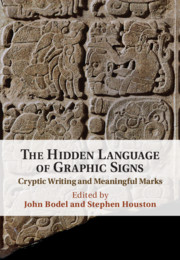Book contents
- The Hidden Language of Graphic Signs
- The Hidden Language of Graphic Signs
- Copyright page
- Contents
- Contributors
- Abbreviations
- Introduction
- Part I Hidden Writing
- Part II Legible Signs
- Seven Marking and Writing in an Egyptian Workmen’s Community
- Eight The Semiotics of Signa and the Significance of Signs in Roman Stamps
- Nine Late Antique and Early Medieval Monograms
- Ten Crests and Familial Identity in Medieval Japan
- Eleven Where Credit’s Due
- Twelve From Modeling to Destruction
- References
- Index
Twelve - From Modeling to Destruction
Cyclicity and Multisensoriality in Learning Doctrine in the Bolivian Highlands
from Part II - Legible Signs
Published online by Cambridge University Press: 23 August 2021
- The Hidden Language of Graphic Signs
- The Hidden Language of Graphic Signs
- Copyright page
- Contents
- Contributors
- Abbreviations
- Introduction
- Part I Hidden Writing
- Part II Legible Signs
- Seven Marking and Writing in an Egyptian Workmen’s Community
- Eight The Semiotics of Signa and the Significance of Signs in Roman Stamps
- Nine Late Antique and Early Medieval Monograms
- Ten Crests and Familial Identity in Medieval Japan
- Eleven Where Credit’s Due
- Twelve From Modeling to Destruction
- References
- Index
Summary
Less glamorous than pottery or architecture, adobe bricks belong to that “Cinderella” class of material culture which archaeologists often ignore. Bricks and their makers’ marks deserve more attention as they can give us invaluable information on the organization and administration of labor. This chapter examines adobe construction and makers’ marks in the Andes, with examples from the ethnographic present and the archaeological past. The author's research on adobe bricks and makers’ marks allows for a theoretical foray into the co-development of labor administration, accounting, and evasion. The chapter argues that the growth of bureaucratic and accounting technology can be modeled as an escalating arms race between tribute payers, local leaders, mid- to high-level administrators, and the uppermost echelon of the state, the royal house. Tracking the evolution of makers’ marks and state accounting unfolds the longue durée of cat-and-mouse mind games played by those who want to capture labor versus those who wish to contribute as little public work as possible.
- Type
- Chapter
- Information
- The Hidden Language of Graphic SignsCryptic Writing and Meaningful Marks, pp. 256 - 284Publisher: Cambridge University PressPrint publication year: 2021

